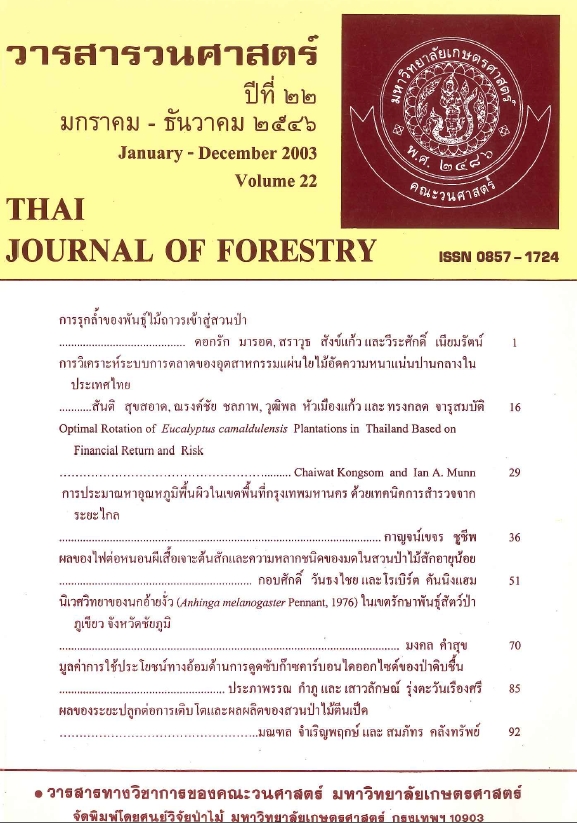การวิเคราะห์ระบบการตลาดของอุตสาหกรรมแผ่นใยไม้อัดความหนาแน่นปานกลางในประเทศไทย
Main Article Content
บทคัดย่อ
การศึกษาครั้งนี้มีวัตถุประสงค์เพื่อศึกษาการผลิต การตลาด โครงสร้างตลาด พฤติกรรมตลาด และผลการดำเนินงานตลาดของแผ่นใยไม้อัดความหนาแน่นปานกลางเพื่อเป็นแนวทางในการวางแผนทางด้านการปลูกสร้างสวนป่า และด้านการตลาดของแผ่นใยไม้อัดความหนาแน่นปานกลางในอนาคต โดยใช้แบบสอบถามในการเก็บรวบรวมข้อมูลที่ต้องการ ผลการศึกษาพบว่ามีโรงงานแผ่นใยไม้อัดความหนาแน่นปานกลางจำนวนทั้งสิ้น 6 โรง วัตถุดิบที่ใช้ในการผลิต ได้แก่ ไม้ยูคาลิปตัส ไม้ยางพารา ชานอ้อย และกาวยูเรียฟอร์มัลดีไฮด์ ปัญหาที่พบในการผลิต ได้แก่ ขาดแคลนวัตถุดิบในฤดูฝน ขาดความรู้เรื่องเครื่องจักร ขาดแรงงานที่มีทักษะ และเงินลงทุนเริ่มแรกสูงด้านการตลาดพบว่า ในปี 2543 มีปริมาณการจำหน่ายทั้งหมด 452,730 ลูกบาศก์เมตร โดยจำหน่ายในประเทศร้อยละ 37.9 และส่งออกร้อยละ 62.1 ปัญหาด้านการตลาดที่พบ ได้แก่ ใช้ไม้ยางพาราเป็นวัตถุดิบทำให้เกิดตำหนิรอยยางไหม้ (latex spot) สินค้าต้นทุนการผลิตของประเทศคู่แข่งมีราคาถูกกว่าทำให้มีการนำแผ่นใยไม้อัดความหนาแน่นปานกลางหนีภาษีเข้ามาตีตลาดในประเทศ โครงสร้างตลาดของแผ่นใยไม้อัดความหนาแน่นปานกลางเป็นแบบผู้ขายน้อยรายที่มีการผูกขาดค่อนข้างสูง ความแตกต่างของสินค้าอันเกิดจากตัวสินค้ามีไม่มากนัก ผู้ผลิตจะเน้นไปที่สร้างความแตกต่างด้านบริการให้กับลูกค้าโดยให้มีบริการก่อนและหลังการขาย อุปสรรคในการเข้ามาดำเนินธุรกิจคือต้องใช้เงินลงทุนขั้นต่ำ 880 ล้านบาท อุปสรรคจากต้นทุนด้านเทคนิคการผลิตและด้านบุคลากรและรวมถึงอุปสรรคจากความแตกต่างในตัวสินค้าทำให้ผู้เข้ามาทำธุรกิจใหม่มีต้นทุนที่สูงกว่าผู้ผลิตรายเก่าสำหรับพฤติกรรมตลาดใช้นโยบายทางด้านราคาโดยมีการรวมกลุ่มในการกำหนดราคา ส่วนนโยบายด้านสินค้าจะเน้นกลยุทธ์ตราสินค้า มีการส่งเสริมการขาย และรับคืนสินค้าที่ชำรุด และผลการดำเนินงานตลาศพบว่า แผ่นใยไม้อัดความหนาแน่นปานกลางหนา 3 มิลลิเมตรมีส่วนเหลื่อมการตลาดสูงสุดคือ 7,663 5 บาทต่อลูกบาศก์เมตร และมีค่าประสิทธิภาพการตลาดจากราคากราคาต่ำสุดคือร้อยละ 160 7 และแผ่นใยไม้อัดความหนาแน่นปานกลางหนา 19 มิลลิเมตรมีส่วนเหลื่อมการตลาดต่ำสุดคือ 4,186.5 บาทต่อลูกบาศก์เมตร และมีค่าประสิทธิภาพการตลาดจากราคาสูงสุดคือร้อยละ 211.2 ส่วนประสิทธิภาพการตลาดทางเทคนิคพบว่าผลต่างระหว่างสัคส่วนราคาขายปลีกต่อต้นทุนการตลาด กับสัดส่วนราคาขายปลีกต่อส่วนเหลื่อมการตลาดของแผ่นใยไม้อัดชนิดความหนาแน่นปานกลางมีค่าสูงมากในทุกความหนาที่ผลิต แสดงให้เห็นว่าผู้ผลิตมีโอกาสผูกขาดในการดำเนินกิจการ ซึ่งเป็นตัวบ่งบอกว่าผลการดำเนินงานตลาดของแผ่นใยไม้อัดความหนาแน่นปานกลางไม่มีประสิทธิภาพ
Downloads
Article Details

อนุญาตภายใต้เงื่อนไข Creative Commons Attribution-NonCommercial-NoDerivatives 4.0 International License.
ข้าพเจ้าและผู้เขียนร่วม (ถ้ามี) ขอรับรองว่า ต้นฉบับที่เสนอมานี้ยังไม่เคยได้รับการตีพิมพ์และไม่ได้อยู่ในระหว่างกระบวนการพิจารณาตีพิมพ์ลงในวารสารหรือสิ่งตีพิมพ์อื่นใด ข้าพเจ้าและผู้เขียนร่วม (ถ้ามี) ยอมรับหลักเกณฑ์และเงื่อนไขการพิจารณาต้นฉบับ ทั้งยินยอมให้กองบรรณาธิการมีสิทธิ์พิจารณาและตรวจแก้ต้นฉบับได้ตามที่เห็นสมควร พร้อมนี้ขอมอบลิขสิทธิ์ผลงานที่ได้รับการตีพิมพ์ให้แก่วารสารวนศาสตร์ คณะวนศาสตร์ มหาวิทยาลัยเกษตรศาสตร์ กรณีมีการฟ้องร้องเรื่องการละเมิดลิขสิทธิ์เกี่ยวกับภาพ กราฟ ข้อความส่วนใดส่วนหนึ่ง หรือ ข้อคิดเห็นที่ปรากฏในผลงาน ให้เป็นความรับผิดชอบของข้าพเจ้าและผู้เขียนร่วม (ถ้ามี) แต่เพียงฝ่ายเดียว และหากข้าพเจ้าและผู้เขียนร่วม (ถ้ามี) ประสงค์ถอนบทความในระหว่างกระบวนการพิจารณาของทางวารสาร ข้าพเจ้าและผู้เขียนร่วม (ถ้ามี) ยินดีรับผิดชอบค่าใช้จ่ายทั้งหมดที่เกิดขึ้นในกระบวนการพิจารณาบทความนั้น”


